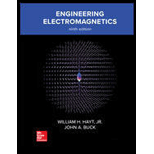
Concept explainers
Consider a problem analogous to the varying wind velocities encountered by transcontinental aircraft. We assume a constant altitude, a plane earth a flight along the x axis from 0 to 10 units, no vertical velocity component, and no change in wind velocity with time. Assume ax to be directed to the east and ay to the north. The wind velocity at the operating altitude is assumed to be:
Determine the location and magnitude of (a) the maximum tailwind encountered; (b) repeat for headwind; (c) repeat for crosswind; (d) Would more favorable tailwinds be available at some other latitude? If so, where?
Want to see the full answer?
Check out a sample textbook solution
Chapter 1 Solutions
Engineering Electromagnetics
- A circle has a center at the origin and has a radius of R. If x = 10 and y = 20, determine the slope of the particular orthogonal trajectory at this point.arrow_forwardFind the surface area of a cone. (Hint: Assume the cone in spherical coordinate system, keepingthe angle θ constant, integrate the differential surface area)arrow_forwardType your question here Let ?⃗ = ? ???∅ ?? + ? ? 2 ???∅ ?? (a) Transform A into rectangular coordinates and calculate its magnitude at p(3, -4, 0). (b) Transform A into spherical system and calculate its magnitude at p( 3, -4, 0).arrow_forward
- hello, i’m studying coordinate system from electromagnetics. In the cartesian coordinate system, the coordinate variables x, y, and z are already length dimensions, so the scaling factors to convert them to length are hx=1, hy=1, and hz=1. In the cylindrical coordinate system, the scaling factors to convert the rho and z into length , are hrho=1 and hz=1. A) what is the hpi that changes coordinate pi into the length? B) in terms of spherical coordinates, what is the hr, htheta , hpi that changes ( r, theta, pi ) of spherical coordinate into the length?arrow_forwardGiven that, in free space ?̅ = ?̅m sin (wt-βz) ?̂y. Find ?̅, and ?̅d. Then show that ?̅. (∇̅ × ?̅)=0arrow_forwardGiven a scalar field V=2xy-yz+xz i.Find the vector representing the direction and magnitude of the maximum rate of increase of V at pointp(2,-1,0) and ii. find the rate of increase of V at point pin the direction toward pointQ(0,2.6)arrow_forward
- Problem 1. Consider an airfoil at a given angle of attack, say α1 . At low speeds, the minimum pressure coefficient on the top surface of the airfoil is −0.90. What is the critical Mach number of the airfoil?Consider the airfoil in Prob. No. 1 at a smaller angle of attack, say α2 . At low speeds, the minimum pressure coefficient is −0.65 at this lower angle of attack. What is the critical Mach number of the airfoil? detailede solution plsarrow_forwardEvaluate the expression for Area of the cone using appropriate “dS” from spherical coordinate system and also discuss values by choosing accurate limits.arrow_forwardAn antenna with power P= 2.2 x 10^3 W is radiating spherical electromagnetic waves. Consider a place which is d = 820 m away from the antenna. - Express I in terms of the electric magnitude Emax, the speed of light c, and the permeability of free space U0. AND - Solve for the numerical value of Emax in volts per meter.arrow_forward
- Evaluate the expression for Area of the sphere using appropriate “dS” from spherical coordinate system and by choosing accurate limitarrow_forwarda. Two vectors A and B are given at a point P(r, Ɵ, Φ) in space as A = 10ar + 30aƟ – 10a Φ B = 3ar + 10aƟ – 20a Φ Determine: 2A – 5B B A X B Repeat the above solution if the two vectors A and B given at a point P(r, Ɵ, Φ) in space reduced by 30 percent. Discuss the differences in solution a and b above.arrow_forwardEvaluate Gauss law for D = 5r2/4 i in spherical coordinates with r = 4m and θ = π/2 as volume integralarrow_forward
 Introductory Circuit Analysis (13th Edition)Electrical EngineeringISBN:9780133923605Author:Robert L. BoylestadPublisher:PEARSON
Introductory Circuit Analysis (13th Edition)Electrical EngineeringISBN:9780133923605Author:Robert L. BoylestadPublisher:PEARSON Delmar's Standard Textbook Of ElectricityElectrical EngineeringISBN:9781337900348Author:Stephen L. HermanPublisher:Cengage Learning
Delmar's Standard Textbook Of ElectricityElectrical EngineeringISBN:9781337900348Author:Stephen L. HermanPublisher:Cengage Learning Programmable Logic ControllersElectrical EngineeringISBN:9780073373843Author:Frank D. PetruzellaPublisher:McGraw-Hill Education
Programmable Logic ControllersElectrical EngineeringISBN:9780073373843Author:Frank D. PetruzellaPublisher:McGraw-Hill Education Fundamentals of Electric CircuitsElectrical EngineeringISBN:9780078028229Author:Charles K Alexander, Matthew SadikuPublisher:McGraw-Hill Education
Fundamentals of Electric CircuitsElectrical EngineeringISBN:9780078028229Author:Charles K Alexander, Matthew SadikuPublisher:McGraw-Hill Education Electric Circuits. (11th Edition)Electrical EngineeringISBN:9780134746968Author:James W. Nilsson, Susan RiedelPublisher:PEARSON
Electric Circuits. (11th Edition)Electrical EngineeringISBN:9780134746968Author:James W. Nilsson, Susan RiedelPublisher:PEARSON Engineering ElectromagneticsElectrical EngineeringISBN:9780078028151Author:Hayt, William H. (william Hart), Jr, BUCK, John A.Publisher:Mcgraw-hill Education,
Engineering ElectromagneticsElectrical EngineeringISBN:9780078028151Author:Hayt, William H. (william Hart), Jr, BUCK, John A.Publisher:Mcgraw-hill Education,





